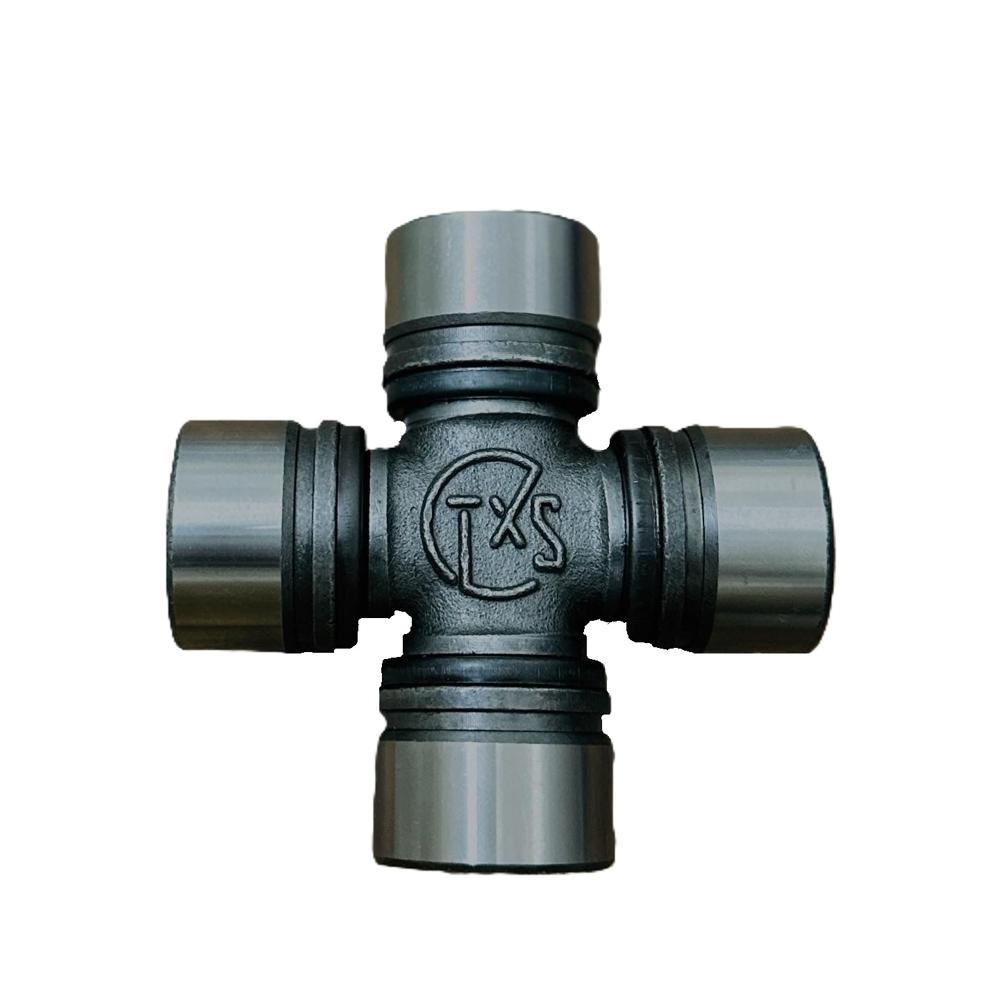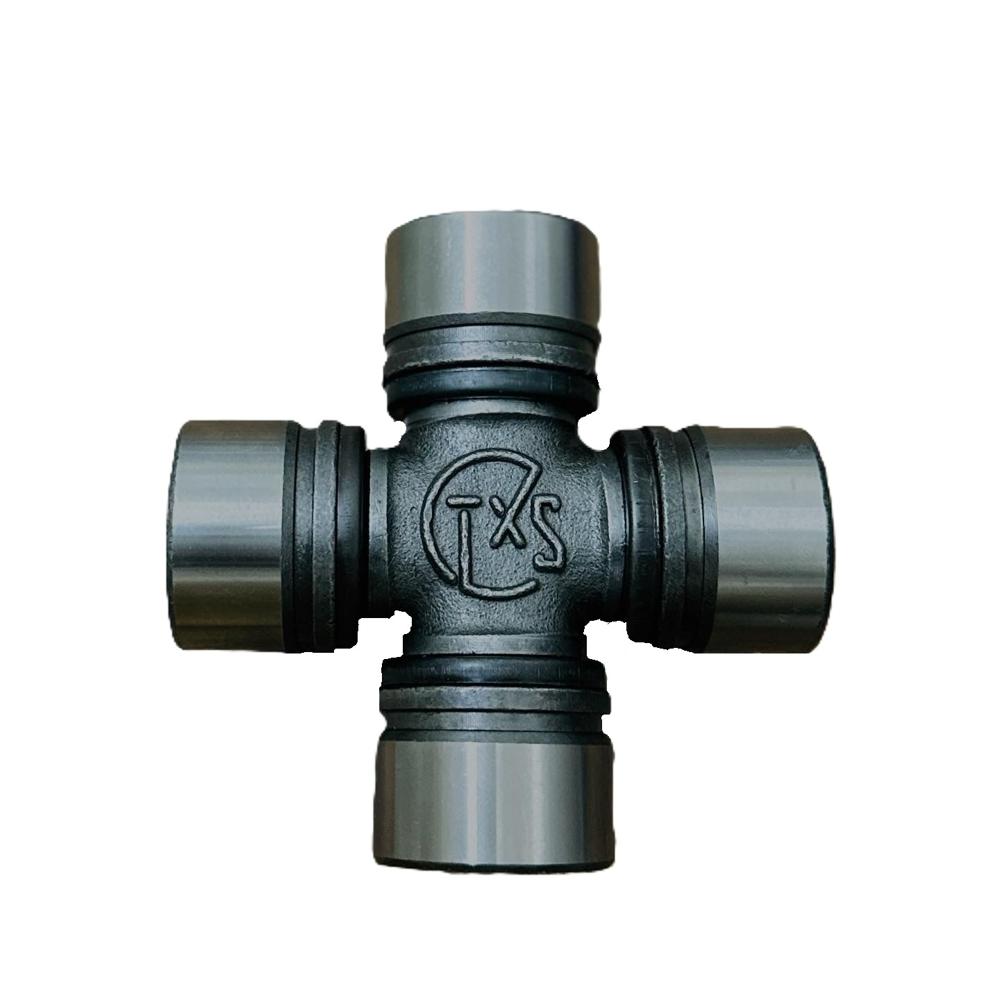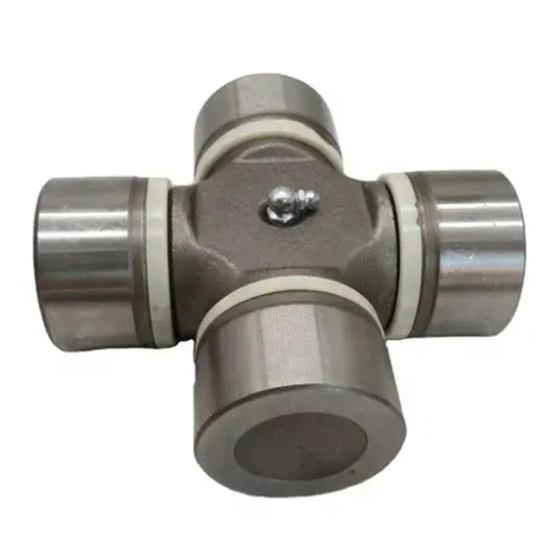Universal joint pto texas
Product Details:
- Shape Cross
- Features The **Universal Joint Cross (U-joint Cross)** has several key features that make it crucial for power transmission in various mechanical systems. Here's a brief overview of its main features: 1. **Cross-Shaped Design**: The U-joint cross is cross-shaped with four arms, allowing it to connect two misaligned shafts and transmit rotational power between them. 2. **Durable Material**: Made from **high-strength steel** or **alloy steel**, designed to withstand high torque and stress. 3. **Lubrication**: Typically includes **grease fittings** for easy lubrication, reducing friction and extending the life of the joint. 4. **Flexibility**: Can accommodate angular misalignments (typically 10 to 45 ) between shafts, allowing smooth power transfer even when the shafts are not perfectly aligned. 5. **High Load Capacity**: Engineered to handle significant torque and heavy loads, making it suitable for demanding applications. 6. **Corrosion Resistance**: Often treated with **anti-corrosion coatings** (like zinc or phosphate) to protect against rust and environmental factors. 7. **Versatile Applications**: Used in automotive driveshafts, agricultural machinery, and industrial equipment, where flexible shaft connections are required. 8. **Shock Absorption**: Designed to absorb shocks and vibrations, ensuring smoother operation in heavy-duty systems. 9. **Easy Maintenance**: Greaseable design makes it easy to maintain and extend its lifespan through regular lubrication. These features ensure the U-joint cross can effectively transmit power, endure tough conditions, and offer longevity in various mechanical systems.
- Usage & Applications Agriculture machinery, Rotavator, Tiller, Reaper
- Noise Level db
- General Use Agriculture machinery, Rotavator, Tiller, Reaper
- Weight (kg) 1.2 Kilograms (kg)
- Drive Type Gear Drive
- Click to View more
Universal joint pto texas Price And Quantity
- 100 Piece
- 320.0 INR/Piece
Universal joint pto texas Product Specifications
- Gear Drive
- Carbon Steel
- db
- Agriculture machinery, Rotavator, Tiller, Reaper
- The **Universal Joint Cross (U-joint Cross)** has several key features that make it crucial for power transmission in various mechanical systems. Here's a brief overview of its main features: 1. **Cross-Shaped Design**: The U-joint cross is cross-shaped with four arms, allowing it to connect two misaligned shafts and transmit rotational power between them. 2. **Durable Material**: Made from **high-strength steel** or **alloy steel**, designed to withstand high torque and stress. 3. **Lubrication**: Typically includes **grease fittings** for easy lubrication, reducing friction and extending the life of the joint. 4. **Flexibility**: Can accommodate angular misalignments (typically 10 to 45 ) between shafts, allowing smooth power transfer even when the shafts are not perfectly aligned. 5. **High Load Capacity**: Engineered to handle significant torque and heavy loads, making it suitable for demanding applications. 6. **Corrosion Resistance**: Often treated with **anti-corrosion coatings** (like zinc or phosphate) to protect against rust and environmental factors. 7. **Versatile Applications**: Used in automotive driveshafts, agricultural machinery, and industrial equipment, where flexible shaft connections are required. 8. **Shock Absorption**: Designed to absorb shocks and vibrations, ensuring smoother operation in heavy-duty systems. 9. **Easy Maintenance**: Greaseable design makes it easy to maintain and extend its lifespan through regular lubrication. These features ensure the U-joint cross can effectively transmit power, endure tough conditions, and offer longevity in various mechanical systems.
- Agriculture machinery, Rotavator, Tiller, Reaper
- any
- Gear Straight Driving
- Cross
- 1.2 Kilograms (kg)
- 38 Millimeter (mm)
- 102 Millimeter (mm)
Universal joint pto texas Trade Information
- transport
- Cash Advance (CA) Cash in Advance (CID)
- 100 Piece Per Day
- 10 Days
- No
- Sample costs shipping and taxes has to be paid by the buyer
- The **packing** for a **Universal Joint Cross (U-joint Cross)** is crucial for protecting the component during storage, transportation, and handling. Proper packaging ensures that the U-joint cross remains free from damage, corrosion, and contamination. Here s a detailed overview of how a U-joint cross is typically packed: ### 1. **Protective Wrapping**: - **Plastic Film or Polyethylene Bags**: - The U-joint cross is often wrapped in **plastic film** or placed in a **polyethylene bag** to protect it from moisture, dirt, and dust. - This type of packaging also helps to prevent the U-joint from coming into direct contact with other materials that could cause scratching or damage. ### 2. **Lubrication or Greasing**: - **Grease Coating**: - In many cases, U-joint crosses are coated with **grease** before being packed. The grease helps to **protect against rust** and **corrosion** during transportation and storage. - The grease also provides some lubrication to the joints, ensuring they remain in good condition before installation. - **Grease Fitting Protection**: - If the U-joint cross has grease fittings (zerk fittings), these may be sealed with plastic caps or covers to prevent dirt and moisture from entering the fitting during transport. ### 3. **Cushioning Materials**: - **Foam or Rubber Padding**: - Inside the packaging box or crate, **foam** or **rubber padding** is often used to cushion the U-joint cross and protect it from shock or vibration during shipping. This cushioning material helps absorb impacts and ensures that the part doesn t get damaged. - **Bubble Wrap**: - Some manufacturers use **bubble wrap** to further protect the U-joint cross from external pressure or impacts. ### 4. **Carton Boxes or Crates**: - **Individual Packaging**: - For smaller shipments or retail sales, the U-joint cross is typically packed in a **sturdy cardboard box**. This box is often labeled with the part number, specifications, and manufacturer's information. - The box is designed to hold the U-joint cross securely and prevent any movement that could cause damage. - **Bulk Packaging**: - In cases where multiple U-joint crosses are shipped together (e.g., wholesale or bulk shipments), they are packed in larger **cardboard boxes** or **wooden crates**. These bulk packages will often contain multiple units of the same part, and extra padding or dividers may be used to prevent contact between individual units. ### 5. **Sealing and Labeling**: - **Plastic Sealing**: - The outer package may be sealed with **plastic shrink wrap** or **adhesive tape** to ensure that the packaging remains intact during transportation. - **Identification Labels**: - The packaging typically includes **part number labels**, which indicate the exact model or type of U-joint cross. These labels help to ensure that the correct part is delivered to the customer. - Labels may also include **manufacturing details**, **batch numbers**, and **handling instructions** (e.g., "Fragile" or "Keep Dry"). ### 6. **Handling Instructions**: - **Warnings and Caution Labels**: - Some U-joint cross packages may include handling instructions, such as warnings to keep the part dry or avoid excessive force on certain parts of the packaging. ### 7. **Environmental Protection**: - **Moisture Absorbents**: - For longer shipments or in areas with high humidity, **silica gel packs** or other moisture-absorbing materials may be included inside the packaging to prevent rust and corrosion from forming on the U-joint cross. --- ### Summary of Packing Details for Universal Joint Cross: 1. **Wrapping**: Plastic film or polyethylene bag to protect from dust and moisture. 2. **Lubrication**: Greased or coated for rust protection. 3. **Cushioning**: Foam, bubble wrap, or rubber padding to absorb shock and prevent damage. 4. **Packaging Box**: Individual or bulk packaging in sturdy cardboard boxes or wooden crates. 5. **Sealing**: Shrink wrap or tape for securing the package. 6. **Labeling**: Part numbers, manufacturer details, and handling instructions. 7. **Environmental Protection**: Moisture-absorbing materials like silica gel packs. The packaging process is designed to ensure that the U-joint cross reaches the end user in optimal condition, ready for installation and use without issues.
- Africa Asia Australia Central America North America South America Eastern Europe Western Europe Middle East
- All India South India Central India West India North India East India Gujarat Karnataka Kerala Lakshadweep Mizoram Meghalaya Manipur Andhra Pradesh Bihar Chandigarh Daman and Diu Punjab Assam Delhi Dadra and Nagar Haveli Andaman and Nicobar Islands Arunachal Pradesh Chhattisgarh Haryana Himachal Pradesh Jammu and Kashmir Goa Jharkhand Odisha Madhya Pradesh Maharashtra Nagaland Rajasthan Sikkim Tamil Nadu Telangana Tripura Pondicherry Uttar Pradesh Uttarakhand West Bengal
- UDYAM CERTIFICATE : UDYAM-PB-12-0200795
Product Description
A Universal Joint Cross (also known as a U-joint cross) is a crucial component in the driveline of various types of machinery, including automobiles, agricultural equipment, and industrial machinery. It serves as the central part of a universal joint (U-joint), which is designed to transmit rotary motion and power between shafts that are not in perfect alignment with each other.
Description of a Universal Joint Cross:
-
Shape and Structure:
-
The U-joint cross is typically a cross-shaped metal component with four arms extending out from a central hub. Each arm has a bearing at the end where the U-joint connects to the drive shafts or yokes.
-
The shape of the U-joint cross allows it to pivot at different angles, transmitting power through shafts that are misaligned (i.e., when the shafts are at an angle to one another).
-
-
Material:
-
The cross is usually made of high-strength steel, forged steel, or alloy steel for durability and strength, as it needs to withstand high torque and stresses.
-
It may also undergo heat treatment to improve its hardness, toughness, and fatigue resistance.
-
-
Function:
-
The primary purpose of the U-joint cross is to transfer rotational motion and torque from one shaft to another while allowing for flexibility in the shaft alignment. This flexibility is crucial in applications where the shafts are not aligned perfectly in a straight line, such as in a cars driveshaft or a tractors PTO shaft.
-
The U-joint cross enables the two shafts to rotate at different angles while keeping the rotational force flowing smoothly between them.
-
-
Lubrication:
-
To ensure smooth operation and longevity, U-joint crosses often include grease fittings (zerk fittings). These allow regular lubrication to reduce friction and wear within the joints.
-
Regular greasing is essential to keep the bearings and moving parts well-lubricated, which helps prevent overheating and premature wear.
-
-
Applications:
-
Automobiles: In vehicles, the U-joint cross connects the driveshaft to the axle, allowing the driveshaft to transmit torque from the engine to the wheels, even as the axle moves up and down.
-
Agricultural Equipment: In machinery like tractors, the U-joint cross transmits power from the tractors PTO shaft to implements like plows, harvesters, and seeders.
-
Industrial Equipment: Used in conveyor belts, cranes, and other heavy machinery, where there is a need for flexible shaft connections.
-
-
Durability:
-
U-joint crosses are designed to handle a range of stresses, including heavy loads, high speeds, and exposure to harsh conditions such as moisture, dust, and extreme temperatures.
-
Many U-joint crosses are treated or coated with anti-corrosion materials to extend their lifespan, especially in agricultural and industrial environments.
-
-
Types and Variants:
-
There are several different types of U-joint crosses depending on their application, including:
-
Standard U-joint Cross: Used for light to medium-duty applications.
-
Heavy-Duty U-joint Cross: Designed for high-torque, high-load situations, often used in trucks, construction equipment, and agricultural machinery.
-
Greaseable U-joint Cross: Features grease fittings for regular lubrication, increasing the component's lifespan.
-
-
How It Works:
The U-joint cross works by allowing two shafts to transfer torque even when they are not perfectly aligned. As the shafts rotate, the U-joint cross pivots within its bearing points, allowing the shafts to operate at various angles. This flexibility prevents damage to the shafts and other components while ensuring continuous power transmission.
Key Points:
-
Material: Typically high-strength, forged steel.
-
Shape: Cross-shaped with four arms.
-
Purpose: Transfers rotational motion between misaligned shafts.
-
Lubrication: Includes grease fittings to ensure smooth operation.
-
Applications: Found in automotive drivetrains, agricultural machinery, and industrial machines.
The U-joint cross is essential for power transmission in many mechanical systems, ensuring smooth operation and preventing damage to parts caused by misalignment.

Price:
- 50
- 100
- 200
- 250
- 500
- 1000+





